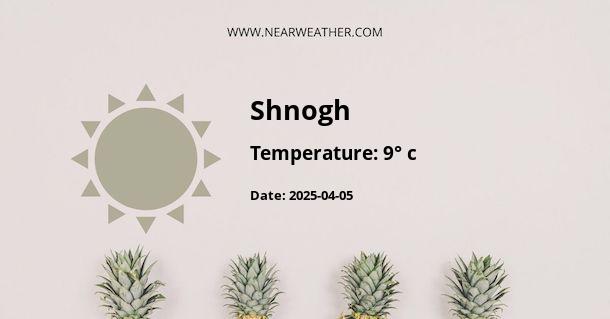Climate and Weather in Shnogh, Armenia
Located in the Lori Province of Armenia, Shnogh experiences a diverse climate with distinct seasons throughout the year. The region is characterized by its picturesque mountainous landscapes and is known for its rich cultural heritage. Understanding the climate and weather patterns is essential for both locals and visitors to plan their activities and make the most of their time in Shnogh.
Temperature
The temperature in Shnogh varies significantly across the different seasons. Summers are generally warm and pleasant, while winters can be quite cold. Here is a breakdown of the average monthly temperatures in Shnogh:
| Month | Average High (°C) | Average Low (°C) |
|---|---|---|
| January | -2 | -8 |
| February | 0 | -6 |
| March | 5 | -2 |
| April | 12 | 3 |
| May | 19 | 9 |
| June | 24 | 14 |
| July | 28 | 18 |
| August | 27 | 17 |
| September | 23 | 12 |
| October | 16 | 6 |
| November | 8 | 1 |
| December | 1 | -5 |
As the table shows, the coldest months in Shnogh are January and February, with average lows around -8°C. July and August are the warmest months, with average highs of 28°C. It is important to note that these temperatures are averages and can vary from year to year.
Precipitation
Shnogh experiences a moderate amount of rainfall throughout the year, with the highest precipitation occurring in spring and autumn. Here is an overview of the average monthly rainfall in Shnogh:
| Month | Average Rainfall (mm) |
|---|---|
| January | 28 |
| February | 26 |
| March | 31 |
| April | 43 |
| May | 70 |
| June | 65 |
| July | 52 |
| August | 37 |
| September | 34 |
| October | 25 |
| November | 31 |
| December | 29 |
From the table, we can observe that May and June receive the highest amount of rainfall, making spring a relatively wet season. Autumn, particularly October and November, also experiences a fair amount of rainfall. The summer months, July and August, tend to be drier, with rainfall levels dropping to around 37-52mm.
Snowfall
Given its mountainous location, Shnogh experiences significant snowfall during the winter months. The region is known for its beautiful winter landscapes, making it an attractive destination for winter sports enthusiasts. Here is a breakdown of the average snowfall in Shnogh:
| Month | Average Snowfall (cm) |
|---|---|
| January | 40 |
| February | 45 |
| March | 30 |
| April | 9 |
| May | 0 |
| June | 0 |
| July | 0 |
| August | 0 |
| September | 0 |
| October | 4 |
| November | 18 |
| December | 35 |
As the table indicates, the highest snowfall occurs in January and February, with an average of 40-45cm. Snowfall gradually decreases from March onwards, and by May, there is typically no snowfall. However, it is important to note that these figures are averages, and actual snowfall can vary from year to year.
Best Time to Visit
The best time to visit Shnogh depends on personal preferences and the desired activities. The summer months, from June to August, offer pleasant temperatures for outdoor activities such as hiking and exploring the natural beauty of the region. However, if you are interested in experiencing the winter wonderland of Shnogh and engaging in winter sports, the period from December to February is ideal due to the abundant snowfall.
It is recommended to check weather forecasts and road conditions before planning a trip to Shnogh, particularly during the winter months, as heavy snowfall can affect transportation.
Overall, Shnogh provides a diverse climate throughout the year, with warm summers, cold winters, and moderate rainfall. Whether you prefer outdoor adventures in the summer or winter sports in the snowy months, Shnogh has something to offer for every season.
A - Shnogh's Latitude is 41.146931 & Longitude is 44.840431.
A - Weather in Shnogh is 12° today.
A - Climate Conditions in Shnogh shows overcast clouds today.
A - Humidity in Shnogh is 75% today.
A - Wind speed in Shnogh is 6.62 km/h, flowing at 223° wind direction. today.
